Construction of Tall Buildings in India
Legislative Framework
India with its States and Union territories has a constitutional and political system which has some federal features. The foundation source of law in India is the Constitution which, in turn, gives due recognition to statutes, case law and customary laws that are consistent with its dispensations. Statutes are enacted by Parliament, State Legislatures and Union Territory Legislatures. There is also a vast body of laws known as subordinate legislation in the form of rules, regulations and by laws made by Central and State Governments and local authorities like Municipal Corporations, Municipalities, Gram Panchayats and other local bodies. This subordinate legislation is made under authority conferred or delegated either by Parliament or State or Union Territory Legislature. The decisions of the Supreme Court are binding on all Courts within the territory of India. As India is a land of diversity, local customs and conventions which are not against statute and, morality are, to a limited extent, also recognised and taken into account by Courts while administering justice in certain spheres.
The Indian Parliament is competent to make laws on matters set out in the Union List. State Legislatures are competent to make laws on matters set out in the State List. Both the Union and the States have the power to legislate on matters set out in the Concurrent List, only the Parliament has the power to make laws on matters not included in the State List or the Concurrent List. In the event of conflict or discrepancy, laws made by Parliament shall prevail over laws made by State Legislatures to the extent of such conflict or discrepancy. The State law shall be void unless it has received the assent of the President, and in such case, it shall come into force in that State.
 |
| Imperial-Tower |
Land, and issues associated with land, including utilization and development of land, as a subject matter of legislation, falls within the legislative power of the State. The State legislatures are aided by local governing authorities who help in all matters relating to land. These local bodies are present in every State and include municipal corporations, improvement trusts, district boards, mining settlement authorities and other local authorities for the purpose of local self government or village administration. The Land Laws in totality comprises separate areas under which different laws are framed such as the Land Revenue Code, Rent Control Act, Tenancy and Agricultural Act, Land Reforms, Land Acquisition Act, Town and Country Planning Act, Land Ceiling Act etc.
Strategic Planning / Zoning
With the objective of bringing consistency in the development and utilization of land in the States, the Central Government, in consultation with the States, has established local town and country planning authorities. These authorities have been constituted with the objectives of: (i) creating conditions favourable for planning and re planning of urban and rural areas with a view to providing full civil and social amenities for people; (ii) stopping uncontrolled development of land due to land speculation and profiteering in land; (iii) preserving and improving existing recreational facilities and other amenities contributing towards balanced use of land and (iv) directing future growth with a view to ensuring desirable standards of environmental health and hygiene and creating facilities for the orderly growth of industry and commerce.
 |
| Sunshinetowertower |
The town and country planning authorities are responsible for preparing a development plan which generally indicates the manner in which the development and improvement of an area are to be carried out and regulated. The outline development plan usually includes (i) a general land use plan and zoning of land use for residential, commercial, industrial, agricultural, recreational, educational and other public purposes; (ii) proposals for roads and highways and widening of such roads and highways in congested areas; (iii) proposals for the reservation of land for the Government; (iv) proposals for declaring certain areas as areas of special control development in such areas being subject to such regulations as may be made in regard to building line, height of buildings, floor area ratio, architectural features and such other particulars and (v) such other proposals for public or other purposes as may from time to time be approved by the planning authority or directed by the relevant government in this behalf. Zoning regulations are stipulated by planning authorities in relation to building line and height of buildings are made in the context of the adjoining street or streets. In such circumstances, prior to initiating any action on proposed development, it is advisable to seek clear written clarification from the planning authority describing the nature and extent of development that may be undertaken at the proposed site.
The comprehensive zoning of land use for any area includes the following zones, namely: residential, commercial (retail or whole sale business), industrial (light, medium and heavy), public and semi public utilities and services, parks and open spaces and playgrounds, transport and communication, agricultural land and wetlands (Green Belt). Agricultural lands in many States possess protected status and are the subject matter of multiple laws and regulations. In most States, lands which are notified for agricultural purposes by the planning authorities cannot be acquired by non agriculturists or utilized for non agricultural purposes without prior governmental approval.
Development Control
The National Building Code of India ("NBC") is a comprehensive building Code providing guidelines for regulating building construction activities across the country. It serves as a Model Code for adoption by all agencies involved in building construction works, be it Public Works Departments, other government construction departments, local bodies or private construction agencies. The Code mainly contains administrative regulations, development control rules and general building requirements, fire safety requirements, stipulations regarding materials, structural design and construction (including safety) and building and plumbing services.
The NBC was first published in 1970. As a result of further developments in the field of building construction, including the lessons learnt in the aftermath of number of natural calamities like devastating earthquakes and super cyclones witnessed by the country, a project for comprehensive revision of NBC was taken up, involving as many as 400 experts, and resulting in the development of a revised NBC the National Building Code of India 2005 (NBC 2005).
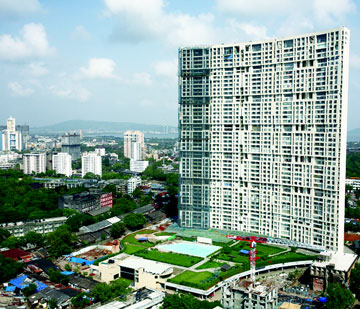 |
| Planet Godrej Mumbai |
The NBC contains regulations which can be immediately adopted or enacted for use by various departments, municipal administrations and public bodies. It lays down a set of minimum provisions designed to protect the safety of the public with regard to structural sufficiency, fire hazards and health aspects of buildings. So long as these basic requirements are met, the choice of materials and methods of design and construction is left to the ingenuity of the architect and the engineer. The NBC also covers aspects of administrative regulations, development control rules and general building requirements, fire protection requirements, stipulations regarding materials and structural design, rules for design of electrical installations, lighting, air conditioning and lifts, regulation for ventilation, acoustics and plumbing services, such as water supply, drainage, sanitation and gas supply, measures to ensure safety of workers and public during construction, and rules for erection of signs and outdoor display structures.
Presently, in most States development controls are exercised through local laws but these laws are inadequate to completely address development controls relating to tall buildings. Some States have revised their existing by laws and regulations to adopt the guidelines provided in the NBC, while some States are in the process of modernizing their existing regulatory frame work by introducing new specifications, revised hand books and manuals and proposing changes to existing building by laws. In spite of the best efforts to implement the NBC, the revised building by laws finalized have not yet been adopted in many States due to procedural bottlenecks.
States exercise development controls through various local laws and regulations. The governance and control of planning, construction and licensing of buildings is vested with local authorities under a framework legislation which is commonly referred to as the Municipalities Act. This legislation is a comprehensive statue dealing with multifarious issues of municipal administration and includes rules, by laws and regulations relating to the construction of tall buildings. Most Indian statutes refer to tall buildings as 'high rise building'. The development control regulations of some States distinguish a high-rise building in terms of its height. Some State by laws define a high rise building as being 35 meters or greater in height, which is divided at regular intervals into, levels able to be occupied. A high rise building is distinguished from all other manmade structures by the following general guidelines:
- Must be divided into multiple levels of at least 2 meters height;
- If it has fewer than 12 interval levels, then the highest undivided portion must not exceed 50% of the total height;
- Distinct divisions of levels such as stairways shall not be considered floors for the purposes of eligibility of this definition.
Consents and Permits
Where a high rise building is proposed to be built, its site must fall within the appropriate zoning area in accordance with the local development plan and zoning regulations provided by the planning authority building either cannot be built or prior approvals would have to be obtained from the local planning authorities for changing the existing land use. Planning authorities for some cities have zoned special areas for the construction of high rise buildings. If a high rise building is proposed in a residentially zoned area then prior approvals would have to be obtained from the local planning authorities.
Construction of high rise buildings involves a number of approvals and permissions from the Municipality or the Planning Authority (together hereinafter referred to as the "Appropriate Authority"), whichever is the relevant authority. The developer may first have to apply for bifurcation or amalgamation of the plot or conversion of land from the appropriate authorities. Thereafter, the developer has to apply for a license for construction of a building. The application has to be filed with the Appropriate Authority and this application must be accompanied by previously sanctioned drawings, key plan, site plan and the building plan. Once the license is issued, the developer has to obtain a commencement certificate from the Appropriate Authority. The limitation period for commencement of work once the license has been obtained is generally two years (this limitation may vary from one State to another).
Before commencement of construction, a No Objection Certificate has to be obtained from the following authorities:
- Water Supply & Sewerage Board, a local body responsible for the supply of potable water and treatment of sewage;
- Fire Services Department;
- Airport Authority of India; and
- Telecommunication Department (in case of high rise building above 7 floors).
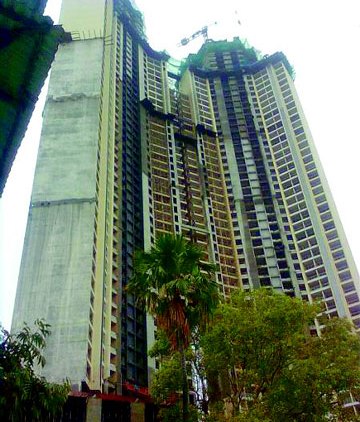 |
Pre and post construction licenses must be obtained from the above listed authorities. These authorities work in close coordination with the Appropriate Authorities and assess the feasibility of constructing a high rise building and whether local infrastructure and amenities are capable of supporting the development on a long term basis. While preparing building plans for approvals from Appropriate Authorities the building should be provided with proper setbacks as per specifications provided in the local building by laws. Should there be any deviation from the specified setbacks, the building will be considered non compliant. Setbacks are minimum open spaces required to be maintained between the plot boundary and the building proposed to be constructed. They are meant to ensure light, ventilation and privacy not only to the development under consideration but also to the neighbouring buildings. In large buildings setbacks serve as circulation spaces and facilitate parking of vehicles. In the case of high rise buildings they are required not only for the movement of fire tenders around the building but also for preventing the fire from spreading to neighbouring buildings. In case of high rise buildings the setback required is directly proportional to the height of the building. The minimum required setback is 9 m and increases as the height of the building increases.
A building license fee has to be paid and a ground rent for stockpiling of building materials on public space has to be paid to the Appropriate Authority. The sanctioned plan and building construction license must be displayed at the construction site.
During construction, engineers appointed by the Planning Authorities will inspect the works to confirm whether the construction is in conformity with the approved building plans. The Planning Authorities are empowered to conduct any number of visits to the construction site to ensure that the construction activity is not interfering unduly with the immediate surroundings. Regular checks are also undertaken to inspect facilities offered to workmen including occupational safety and health facilities. The area executive engineer and assistant executive engineer usually inspect the construction on three occasions: first when the building reaches the plinth level, then when work reaches the lintel level and finally, after the construction is completed. At the final stage, an occupancy certificate will be issued only if it is found that the builder has not deviated from the sanctioned plan.
Main Issues
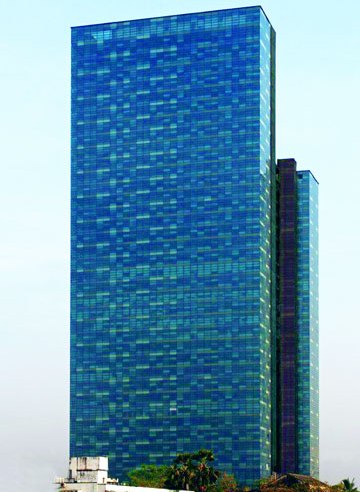 |
The growth in the Indian economy has given rise to significant real estate demand in the housing, retail and commercial sectors. Traditionally, the urban housing sector was dominated by independent dwelling units due to the relatively easy availability of land. But now, with an emerging middle class and a huge migration of population from the villages to the cities, the availability of land in developed cities is fast declining. Local planning authorities on their part are identifying suitable land and creating satellite towns outside the immediate periphery of developed cities to provide for harmonized development of urban infrastructure. [The costs of land in some cities in India are probably amongst the highest in the world.] Although there is no real lack of land, irregular urbanization and unplanned growth has resulted in unprecedented urbanization being restricted to few cities only. Therefore, land is not easily available in these cities and if it is available it is expensive. Therefore, to provide for maximum utilization of available land, the construction of high rise buildings is now seemingly inevitable. Market forces and availability of land are forcing the construction of high rise buildings and large condominiums to achieve maximum utilization of available land. However, the trend of developing high rise buildings in smaller cities and towns is still slow. In smaller cities and towns, availability of land and a subtle market resistance to high rise buildings is limiting the development of high rise buildings.
Town planning authorities in certain cities have set aside areas exclusively for the construction of high rise buildings for both residential and commercial purposes. The land is developed by the State Government and then sold to purchasers by way of an open bid process. Successful bidders have to enter into an agreement with the State Government, agreeing to terms and conditions of the utilization of the land and the nature of development. The only criterion with regard to allocation or utilisation of land seems to be Floor Area Ratio or Floor Space Index. The total built up area that can be constructed on a particular land is calculated on the basis of the Floor Area Ratio (FAR). FAR is the ratio of total built up area above plinth to the plot area.
The FAR is determined by the land use zone in which the land is situated:
- Residential (Main), Residential (Mixed);
- Commercial (Central), Commercial (Business); and
- Mutation Corridors, Commercial Axes, Industrial (General), Industrial (Hi Tech), Public and Semi Public (P&SP).
Present policy regarding tall buildings is based on height restriction for buildings in different use zones. The NBC 2005 lays down a set of minimum provisions designed to protect the safety of the public with regard to structural sufficiency, fire hazards and health aspects in buildings. So long as these basic requirements are met, the choice of materials, method of design and construction is left to the ingenuity of the architect and the engineers and other experts engaged in such projects.
As of today, there are no restrictions with regard to the construction of residential, retail, commercial or mixed tall buildings. The bureau of Indian standards has proposed to come up with a new set of rules for the construction of tall buildings.
Viability of Having Tall Buildings
Growing urbanization in India is causing a cascading effect on urban housing. Low rise structures are being brought down to accommodate high rise buildings in their place. Optimum utilization of energy and natural resources are other factors that support high rise buildings in India. The growing middle class population is looking for an affordable way of residing and high rise buildings are an attractive option.
Undeniably, high rise buildings are also seen as wealth generating mechanisms working in an urban economy. High rise buildings are constructed largely because they can create large areas of real estate out of fairly small pieces of land. Because of the availability of global technology and the growing demand for real estate, skyscrapers are seen as the most fitting solution to any city that has a limited amount of space available and cannot comfortably house its inhabitants. When you compare the population in Indian cities with the amount of land available, it seems that the only way to provide better living conditions is by building higher.
Transportation
The Government of India has formulated a national transport policy to address, amongst other relevant national mobility related aspects, issues relating to integrating land use and transport planning. Cities in India vary considerably in terms of their population, area, urban form, topography, economic activities, income levels, growth constraints. Accordingly, the design of a transport system will have to depend on each city's specific features. Further, transport planning is intrinsically linked to land use planning and both need to be developed together in a manner that serves the entire population. The Government of India has proposed the preparation of an integrated master plan to incorporate the features of sustainable transport systems. In its directive to various Central and State Government transport departments, the Government of India has declared that in the course of developing such plans, attention should also be paid to the future growth of a city around a pre planned transport network, rather than developing a transport system after uncontrolled sprawl has taken place. Transport plans should, therefore, enable a city to take an urban form that best suits the geographical constraints of its location and also one that best supports the key social and economic activities of its residents.
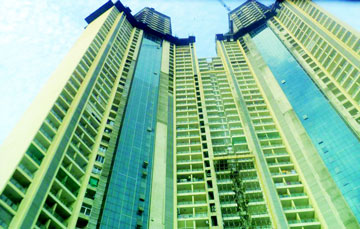 |
Unfortunately, transport planning does not yet receive the level of attention it should in the drawing up of strategic development and land use plans. The Government of India is, therefore, promoting the development of integrated land use and transport plans for all cities. To enable this, all urban development and planning bodies in the States are required to have in house transport planners as well as representation from transport authorities within their management teams. The Government of India has agreed to support the preparation of such integrated land use and transport plans financially also.
Overview of Construction Projects
The construction sector has come a long way and has registered an annual growth rate of over 10 per cent for the past five years. This growth has come despite the sector facing various issues relating to contracting, quality, manpower and technology. The Indian construction sector is a highly fragmented industry. It is dominated by 20 large contractors who account for 40 per cent of the building activity in the country. They often sub contract work to smaller companies. Medium sized contractors get about 20 per cent while smaller players handle the rest.
A majority of construction projects in India, whether in the public or private sector, are tender based. The owner of the proposed development prepares an information memorandum inviting offers from prospective builders who are required to possess minimum qualifications. The tender document, in most cases is quite comprehensive and contains contractual terms and conditions in addition to covering technical and design specifications, contract rate, utilization of resources and workmen, delivery timelines and penalties. The tenders are released to a select group of pre qualified contractors, or in certain cases,
| Ashok-Towers |
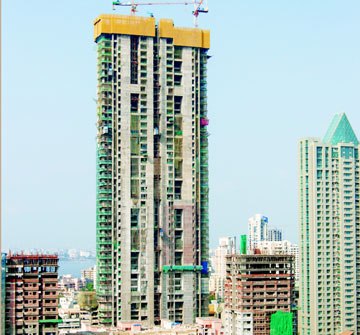 |
the tender is published in local journals and news papers. In some cases, bidders are required to provide separate technical and financial bids. The qualification criteria for selecting the best bidder may be entirely cost driven, but for many critical projects, a weighted average approach is adopted for finalizing the top bidder. The selection process in public or government sector bidding is governed by certain rules and regulations to ensure transparent and unbiased bidding process; in the private sector, prior credentials, references and industry certifications may be a determining factor in addition to the costing. The tenders could be either owner designed or contractor designed. Deals worth up to Rs.200 million are usually owner designed since the owner is responsible for the engineering of the project. For larger turnkey or equipment procurement construction contracts requiring multidisciplinary engineering skills, contractors design the tenders. The latter are more common. Lump sum turnkey contracts are selectively and rarely used in construction projects unless the contractor has a long term interest in the proposed development.
In India, two systems of tendering are generally followed. In projects financed by the World Bank, its affiliates or multilateral agencies, the International Federation of Consulting Engineers (FIDIC) conditions apply. For Public Sector Units (PSUs), State and Union government tenders, variations of the Central Public Works Department contract conditions apply. Construction contracts in the private sector are substantially based on the FIDIC format but industry developed construction contracts are also used extensively. FIDIC forms are definitely gaining wide spread popularity in the private sector as well as in Government sponsored construction projects. Institution defined contracts are not very popular in India and thus the association of builders, engineers or architects have remained antagonistic to the legalities of construction contracts and are quite content leaving this task to lawyers while they focus on technical, structural and creative aspects of the development. Contract management systems and procedures are given significant importance. The contracting and procurement systems prevalent in India, including project deliverables, are dictated by the availability of resources and labour. These factors often lead to delays and cost escalations. The failure to engage reputable project management and procurement consultants results in the developer taking key decisions on project implementation and these may result in unplanned procurement and delivery delays, leading to cost escalations. The written contract and agreement between the developer and the builders may provide for strict time lines and penalties. However, from market practice, it appears that developers and builders have accepted contract flexibility to be a reality and hence, reasonable time and delivery extensions are made without triggering penalty clauses. This practice has given most builders immunity from having to meet strict timelines of quality and timely delivery. Having said this, one cannot assume that this tolerance prevails throughout the industry. It is apparent that project execution is increasingly being addressed with greater professionalism and developers are more often bringing actions against errant builders.
Procurement Routes
Procurement is an essential part of construction process. In India the current procedures for procurement of contractors are highly cumbersome and expensive. The key steps involved in the contract procurement process are "project dialling", (which is the feasibility study and securing of sanctions), preparation of the prequalification document, invitation of techno commercial bids and evaluation of bids along with the final award of work. In India there are no standardized contract procedures or evaluation criteria in place.
There are a number of different procurement routes available to developers. The procurement strategy identifies the best way of achieving the objectives of the construction project taking account of the risks and constraints, leading to decisions about the funding mechanism and asset ownership for the project. The aim of a procurement strategy is to achieve the optimum balance of risk, control and funding for a particular project. It includes the choice of contract that will best meet the of the project developer's needs. An integrated procurement strategy ensures that design, construction, operation and maintenance are considered as a whole. It also tries to ensure that the delivery team work together as an integrated project team.
There are a number of common contracting strategies used in the Indian construction market:
Traditional Construction Contract- In this method the contractor builds to a defined scope of works provided to it by the developer for a fixed price lump sum. The developer retains responsibility for the design and the project team. The contractor will normally be appointed following a tender process or negotiation and will sign up to a contract for the works. There are a number of standard forms of building
contract available for this purpose. The majority of construction projects in India are still tendered under the traditional construction contract. The contractor simply implements the developers design and plans within a pre determined budget. These contracts may be executed by way of a lump sum fee method on a cost and materials basis. In either scenario, the developer remains in control of the design, planning, procurement and development of the project. These contracts are usually budget driven and may result in the contractor compromising on quality and statutory compliances.
Design and Build Procurement- The expanding economy has generated growth in the construction industry, with many new construction projects taking off in recent times. Several large scale projects such as integrated resorts, premium commercial and retail developments and landmark luxury residential properties have been developed. As projects have become more sophisticated and complex, the design and build model has proved to be a popular form of project procurement due to its flexibility in allowing the work to start sooner based on an earlier stage of design, which is then further developed by the Contractor. Design and build procurement is extensively used in the industrial sector and is now being accepted as a practical delivery mode for construction projects as well. Utilising design and build procurement is a major cultural shift and has managed to align the interests of clients, designers, constructors and suppliers through a transparent process of constructability assessment, design development, cost analysis and realistic scheduling. It enables the formation of a cohesive team that benefits from positive partnering and open communication. In India, liability difference encourages an artificial separation between design and construction agencies, creating adverse relationships and unaligned interests. Traditional procurement has hardened into an inefficient mechanism, sometimes incapable of delivering fast track, value engineered solutions that address the need for clients competing in a global economy. Issues encountered in India include limited designer liability coupled with low contractor efficiency and credibility. Clients are rarely the beneficiaries of comprehensive performance guarantees or post completion warranties. Clients are now beginning to demand total facility delivery systems with both design and construction in the hands of a single entity, with a single point of responsibility for quality, cost and adherence to schedule. With design and build procurements, clients are able to focus on timely decision making rather than co coordinating numerous contractors. Regrettably, a lingering perception remains in India that design build procurement is suitable only for the simplest of projects, mostly interiors.
Construction Management Contract
Construction management contracts are a well used alternative to the more straightforward principal/contractor/subcontractor building arrangement. Rather than a principal employing a single contractor as one point of reference for the carrying out of all the works (or the design and construction of the works in the case of a design and construction contract), a construction management contract sees the construction manager, for a fee, acting as the principal's consultant in advising on the employment of subcontractors (called trade contractors) by the principal.
Construction Phase
Payment- Given the nature and magnitude of the work encompassed by a typical building contract and the time taken to complete it, it is normally not possible for any builder to undertake the financial burden of completing the construction as a condition precedent to payment. It has therefore become a normal practice in construction contracts in India, to provide that interim payments are made on account to the contractor during the progress of the work, which are then adjusted and finalized on completion of the project. Such payments only become due to the builder when a certifier confirms that the builder has done the work that he is required to do to entitle him to receive the payment. There are no legislative stipulations governing the payment obligations of statutory dues. The builder is usually responsible for payment of all statutory levies relating to the construction of the project. In certain cases, the developer assumes the builder's statutory payment liabilities and when such payments are discharged by the builder, they are usually reimbursed on cost basis.
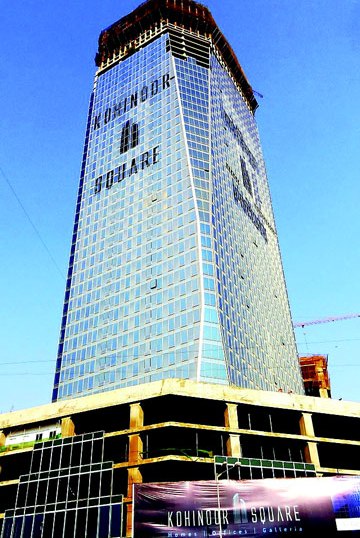 |
| Kohinoor tower |
Employer's security (retention)- Typically, the employer will retain a percentage of each interim payment that is made to the builder, as security for due performance of the work. These are known in the industry as retention monies and also work as a fund to be drawn upon should the occasion either arise to complete the work or to rectify defects the contractor fails to do so.
Generally, the builder is not entitled to the retention money until the work is entirely finished, without defects or missions. In India, the expression "security deposit" is generally used in place of "retention". Sometimes the contractor is required to deposit the whole of the security amount before the employer will enter into a formal contract.
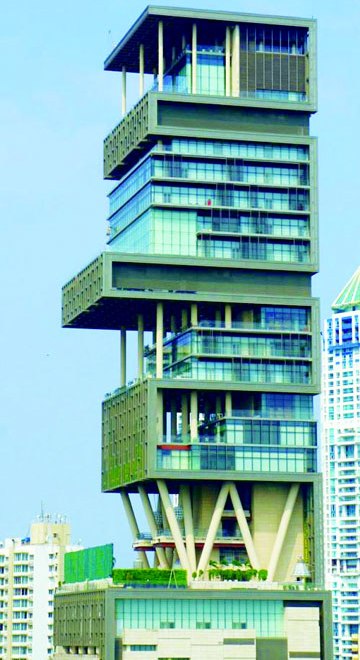 |
| Antilla, Mumbai |
In addition to holding back retention payments, employers may enforce the contractor's obligations by way of obtaining strict guarantee obligations from the builder. The necessity for guarantee in a building contract anises from the nature of the transaction, that is, the time element involved in performance of the contract, risk element inherent in the transaction, investment of large amounts by the owner and handing over the site valuable land comprising the to the builder. Added to this is the uncertainty that the builder will complete on time. In large construction projects in India the practice of procuring a guarantee from the builder is quiet common. In the event of a default by the principal debtor, the creditor will have the right to enforce and call upon the guarantee. Traditionally, guarantees are given by banks, financial institutions or by persons having sound and ascertainable financials. Apart from being required to provide sureties to guarantee the due performance of his contract, the contractor may be required to find sureties to guarantee his banking account and other liabilities which he may incur.
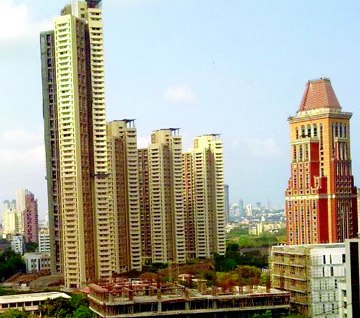 |
| Ashok Tower Mumbai |
Liquidated Damages- Most construction contracts used in the private sector in India contain provision for the payment of liquidated damages by a contractor for breach of contract where the building is not completed on time. The liquidated damages must be set at a level that represents a genuine pre estimate of the loss that is likely to be suffered by the employer caused by such breach.
Liability for defects- The word 'defects' in India is usually taken to indicate any deficiency in the quality of work, whether structural or merely decorative or whether due to faulty material or workmanship or even deficiency in design or performance, if that is a part of the contractor's obligations. The initial express or implied liability of the contractor to carry out and complete work in accordance with the contract description is often followed by a later and separate express liability of the contractor to return or remedy any defect which may become apparent during a stipulated period following completion and hand over. This is the defect liability period. There are various conditions which are inserted into building and engineering contracts in respect of defects, repairs and maintenance. For example:
- A general repairing condition which requires the contractor to keep the works in repair during some fixed period
- after the architect or engineer has given his final certificate;
- A condition that the builder will rectify any defects in materials or work which are discovered within a fixed period;
- A "maintain and uphold" condition under which the contractor may possibly be required to do more than repair;
- A condition that the contractor is to be liable for breach of contract for defective work appearing at any time.
In general, when a contractor undertakes to make good defects discovered within a fixed period, his obligation only extends to defects which are discovered within the fixed period, though the reason or the cause of these defects may not be ascertained before the period has expired. The period during which the obligation to make good defects, to repair or to maintain is to have effect is called the maintenance period, and usually runs from the time the architect certifies that the works are finally completed. A part of the retention fund or a maintenance guarantee is normally retained or obtained as security for the performance by the contractor of its obligations to make good, repair or maintain.
Collateral Warranties- Warranties are an important safe guard against breaches by a contractor in the performance of its obligations. According to Indian Law there are three kinds of warranties:
- To do the work undertaken with appropriate care and skill.
- To use materials of good quality. Where materials are described in the contract, the warranty would require quality of the kind described in the contract. Where materials are not described in the contract then the warranty would be that the materials would be suitable for their intended use and of good quality.
- Both work and the materials must be fit for the purpose for which they are required.
Where there is an express warranty in respect of (iii) above, the builder must ensure that the works are fit for the purpose, and it is not enough for the builder to argue that he has carried out the work in accordance with the plans, designs and specifications. Such warranty must, however, be expressly provided for in the building contract.
Insurance- Insurance is an essential component of a building contract as parties always fear loss or damage occasioned by unexpected events or accidents. The building contract typically specifies the exact risk to be insured and the quantum of insurance, the persons covered by insurance and so on.
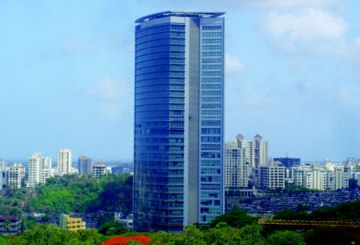 |
| Oberoi-Commerz-1 |
In India construction contractor insurance is used. This type of insurance covers the construction contractor for loss owing to equipment failure or site damage. Depending on the policy wording, injuries or fatalities resulting from site accident, damage to the construction works, equipment malfunctions, explosions, falls or slips and poor construction control are often covered under the construction contractor insurance.
Business risks in construction are somewhat greater than in most other business ventures. The insurance sector in India has not yet recognised the full potential of the sector for insurers. The Construction Industry Development Council of India and the Actuarial Society of India have signed a memorandum of understanding to develop insurance products for use in construction projects. This is expected to facilitate access to insurance for risk prone construction projects.
In addition, there is a new grading system in India which is a major instrument for risk assessment by insurance companies venturing into this area. The premium for various risk coverage can now be rationally computed and thus has become equitable and attractive to construction agencies. The types of risks for which insurance products have been designed by the Construction Industry Development Council are:
• Bidding Indemnity Policy
• Delay in meeting obligations by client policy
• Settlement of claims policy
• Loss of profit policy
• Transit insurance policy
• Loss of performance of construction equipment policy
• Force majeure loss policy
• Casual workman compensation policy
• Financial risk coverage policy
• Life of building policy
To avoid misuse by the purchaser the Construction Industry Development Council has developed a support system comprising grading of construction entities for a more comprehensive and objective assessment of construction entities and a more reliable assessment of risks.
Dispute Resolution for Construction Matters
Construction contracts in India are often prone to some form of dispute resulting in litigation of one form or another. Inadequate or deficient contracting coupled with lack of project documentation and project management often precipitate disputes amongst developers, project managers and contractors. Traditional dispute resolution mechanisms in India are time consuming. Therefore the industry is applying thought and effort to first minimise litigation and second to increase the use of alternative dispute resolution mechanisms as an alternative to litigation.
One difficulty with construction litigation in India is that many Courts are not equipped to handle the technical issues emanating from construction contracts. As the construction industry works on thin margins, expending large amounts of money non productive litigation is considered a big problem. However, court still remains in many situations, the best option to seek immediate interim relief and at times, if the contracting parties do not have good understanding of the functioning of alternative dispute resolution systems, court can be a better alternative.
The construction industry has adopted a multi layered dispute resolution mechanism to address construction disputes, starting with settlement of smaller operational issues arising during the construction phase by way of an escalation matrix. Upon notification of a dispute, the matter is usually first referred to the project managers. If the project manager are unable to resolve the dispute within the defined time frame the matter is escalated and this escalation continues until it reaches the decision makers of the respective contracting parties. If the dispute still remains unsettled then the parties may decided to refer to dispute to court or to an arbitration. Most construction contracts provide for dispute settlement through arbitration. Arbitration is proving to be efficient, timely and relief oriented. Arbitration proceedings in India are governed by the Arbitration and Conciliation Act, 1996 ("Arbitration Act"). If the situs of the dispute is India and the cause of action has arisen in India, it would be better for the parties to choose Indian law as applicable law, however, for the purposes of neutrality, when one of the contracting is not an Indian, the parties may choose a neutral venue for conducting the arbitral proceedings and may agree to be governed by the procedures prevalent in that jurisdiction.
For a dispute to be referred to arbitration the parties must have entered into a is a valid arbitration agreement. The arbitration agreement can simply be a clause in the building contract, or it can be by way of a separate agreement after the dispute has arisen. Next, the arbitrator(s) are appointed according to the arbitration agreement. The arbitrator(s) can decide only upon those issues that are specifically submitted for arbitration.
The arbitrator is not bound by rules of evidence or the rules laid down by the Code of Civil Procedure. The arbitrator, in consultation with the disputing parties, can decide on the procedural aspects of the arbitral proceedings. In the course of arbitration proceedings, the arbitrator can also rely on evidence given by experts to decide specific issues relating to the dispute at hand. The decision of an arbitral tribunal is called an arbitral award. An arbitral tribunal is also competent to issue interim orders and grant declaratory relief to an aggrieved party, including specific performance.
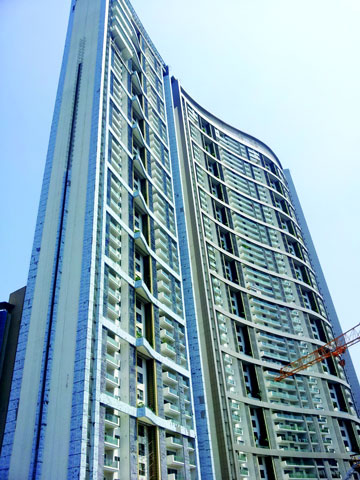 |
| Lodha Bellissimo Mumbai |
The arbitral award is final and binding on the parties and enforceable in the Court. However, the award can be challenged in a court of Law on some limited grounds, including: an invalid arbitration agreement, the arbitrator exceeding his jurisdiction; notice not being validly given to a party. A contract can also contain a clause providing for expert determination of a dispute. This is different from arbitration. In arbitration, the arbitrator hears the arguments of the parties, applies the law and decides the dispute. He does not use his
special expertise. In expert determination, the expert will use his own expertise to come to a conclusion. Expert determination must be expressly provided for in the agreement. The expert's award is final and there is no appeal from it. However, the Arbitration Act now allowsthe arbitrators to use their expertise, thus blurring the distinctions between arbitration and expert determination.
Conciliation
Conciliation is a technique of Alternative Dispute Resolution (ADR) that has now acquired statutory recognition in the Arbitration Act. In contradistinction to arbitration, conciliation can be used to settle or to resolve any conflict or dispute which has arisen between parties in respect of a defined legal relationship, whether contractual or not, and is not controlled or based on any prior agreement between the parties, the idea being that two willing parties can at any stage resolve a dispute in the presence of a conciliator. This technique can be used even after parties resort to litigation, and in fact would be most useful to persons whose cases are pending in courts for several years without any foreseeable outcome.
The chief elements in the conciliation process are the identification of the causes of the disputes and the creation of options to resolve the conflict. By this technique, the parties are encouraged to visualize options that provide solutions, keeping in view the interests and priorities of the parties in question. The Arbitration Act provides a certain structure to the technique of conciliation, whilst at the same time retaining its flexibility and informality. It further provides that if the parties enter into conciliation and reach an agreement on a settlement of the dispute, then they said agreement will have the same status and effect as if it was an arbitral award1[5]. This prevents parties to resile from a settlement, giving this technique of alternate dispute resolution greater credibility. The Act also provides for confidentiality in respect of all matters in conciliation proceedings and in the settlement agreement, except where disclosure is necessary for the purposes of implementation and enforcement. This makes conciliation a useful tool for conflict resolution even in complex commercial disputes.
Enforcement of Foreign Arbitral Awards
Where one of the parties to a construction contract in India institutes arbitration proceedings in a foreign country, an arbitral award made in such foreign arbitration proceedings can be enforced in India under the multilateral international conventions to which India is a party, namely, the Geneva Convention of 1927 or the New York Convention of 1958, if the said Convention applies to the relevant arbitration. The foreign award must have been made in a country that has ratified the Geneva Convention of 1927 or the New York Convention of 1958.
Pursuant to section 48 of the Arbitration Act, there are various grounds upon which an Indian court may refuse to enforce an otherwise enforceable foreign arbitral award. Briefly stated, they are (a) invalidity of the arbitral agreement; (b) a violation of due process; (c) the arbitrator exceeding his authority; (d) irregularity in the composition of the arbitral tribunal or the arbitral procedure; (e) failure of the award to become binding, or its being set aside or suspended in the country in which, or under the law of which, that award was made; (f) non arbitrability of the dispute; and (g) violation of public policy. A court may on its own motion, on either of the last two grounds, decline to enforce a foreign arbitral award.
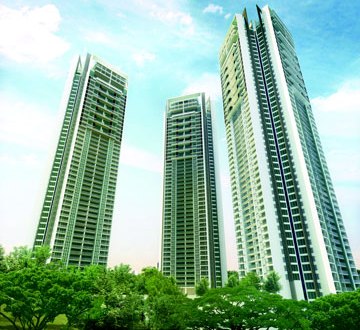 |
| Oberoi Exquisite Tower |
Foreign awards that are made in countries which are not parties to either the Geneva Convention or the NewYork Convention cannot be enforced with the same facility as foreign awards to which the Conventions apply. Such foreign awards are however enforceable in India on the same grounds and in the same circumstances in which they are enforceable under the general law on grounds of justice, equity and good conscience. They can be enforced by an action brought before a court of law. The principles and conditions of enforcement of foreign awards as stated in some of the judgments of Indian courts are as follows: That there was a contract between the parties where under disputes between them were referred to arbitration to a arbitral tribunal in a foreign country, and
- that the award is in accordance with the terms of the agreement,
- that the award is not invalid according to the law governing arbitration proceedings,
- obtaining in the country where the award was made, and
- that it was a subsisting award on the date of suit.
A foreign award will not be enforced by the courts in India if its enforcement would be contrary to the public policy or the laws of India. With a view to providing an institutional mechanism for resolution of construction and infrastructure related disputes, the Construction Industry Development Council, India (CIDC) in cooperation with the Singapore International Arbitration Centre (SIAC) has set up an Arbitration Centre in India called the Construction Industry Arbitration Council (CIAC).
Acknowledgement: The above is a pre published India chapter of the anticipated international report on the legislative, political and organizational frameworks in which tall buildings are being developed and built. For more information on the CTBUH Legal Working Group, please visit http://workinggroups.ctbuh.org.